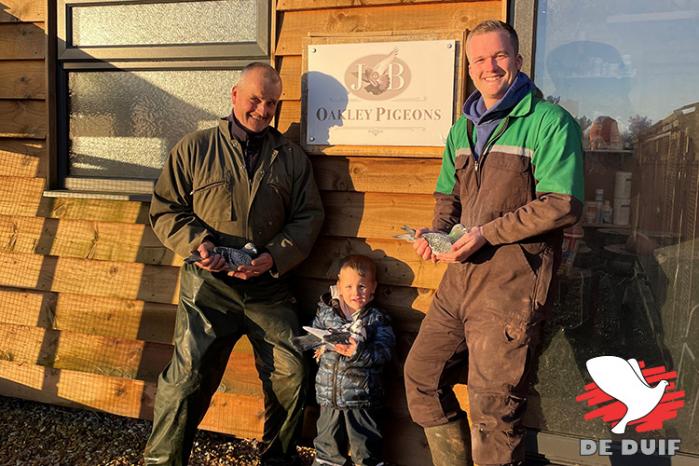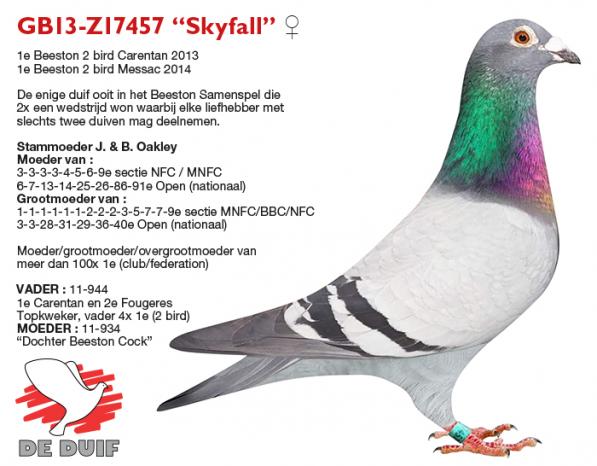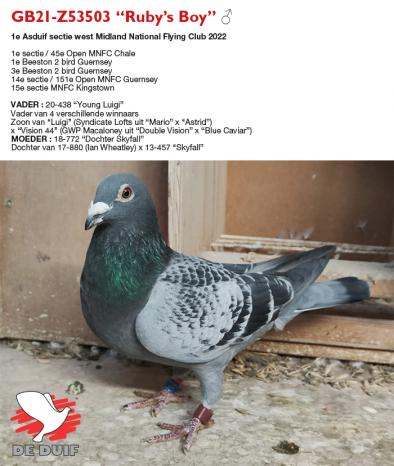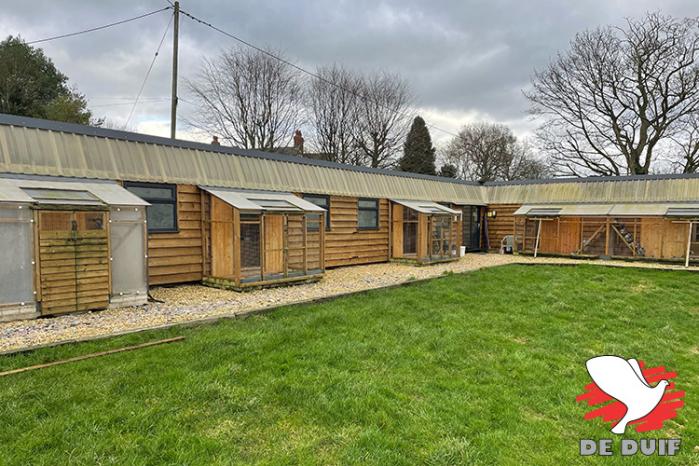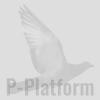Liefhebber:
Onderwerp:
| Lees hier het Nederlandse artikel. |
Whitchurch 3 KM from the Welsh border is the oldest continuously habited town in the County of Shropshire, originally inhabited since 3000 BC it has been continuously habited since its founding in between 52 & 70 AD by the Romans.
In 1981 the “Whitchurch Tornado” was recorded which was the longest lived tornado of a record breaking nationwide tornado outbreak that day, originally hitting the ground 56km away in South Shropsire village of Norbury after passing through Whitchurch it then dissipated.
In the last few years, a different type of Tornado has been seen across the skies of Whitchurch, those flown by the partnership of J & B Oakley!
The partnership consists of John 57 & Ben 32, dairy farmers from an area famous for the special Cheddar Cheese. John started with pigeons the year Ben was born and Ben took an interest from as soon as he was old enough to follow his father into the lofts. They were happy racing in the local Clubs and Feds until 2011 when Ben returned from College and decided to source better pigeons and became more committed to them.
| Cat. 1: old birds 60-225 miles: | |||
| 3.6 Yeovil (142 miles) 16.7 Weymouth (163 miles) |
327 d. 231 d. |
1 2 |
(6 mee) (10 mee) |
| Cat. 2: old birds 225-425 miles: | |||
| 29.4 Guernsey (241 miles) 3.6 Messac (359 miles) |
3219 d. 4504 d. |
3 6 |
(7 mee) (15 mee) |
| Cat. 3: olds birds > 425 miles: | |||
| 25.7 Sigogne (514 miles) | 2493 d. | 25 | (18 mee) |
| Cat. 4: young birds 60-175 miles: | |||
| 2.9 Frome (125 miles) | 675 d. | 1 | (33 mee) |
| Cat. 5: young birds > 175 miles: | |||
| 2.9 Carentan (261 miles) | 2316 d. | 15 | (12 mee) |
| Coefficient: 43,85 pts. | |||
Shropshire Federation
The team is raced in the Shropshire Fed which is 105 KM from first to last drop and 80km from East to West where they are among the furthest fliers and they also switch pigeons to the Mid Cheshire Fed in which they are shortest flyers with pigeons up to 80km behind them (but this involves a 90 minute round trip) competing to get them used to a different line for National races, at Fed level they race to the South Coast which is 261 KM and then from the South Coast, Channel Islands and France with 3 different National Clubs, (Midlands National Flying Club, the National Flying Club and the British International Championship Club).
With Whitchurch being a rural location and the pigeon sport being changing due to loss of membership and local Clubs having to merge and losing members to the National Clubs the number of competing members/pigeons has reduced in recent years in Fed racing.
Ben noticed good “local” pigeons struggled at National races, yet from Coastal races super Fed pigeons were behind despite multiple top results via the local Club and Fed from the same race point, yet teammates who were lower down the result in the Club and Fed were hitting the first page of the National result and top prizes in the Section of the National.
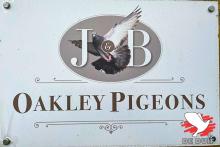 Base of the family
Base of the family
2 good hens were retired and bred around to form the base of the family and then in 2018 pigeons were introduced from the Macaloney Family of Lanarkshire in Scotland (former Golden Duif UK & RoI winners) which were crossed with their own “Skyfall” lines and the results became more consistent at National level, clocking from every race and having multiple timers in the result. Highlights in recent seasons include 3rd National Guernsey British International Championship Club, 6th Open Messac National Flying Club, 1 to 12th places in the Fed (Samenspel) with Old Birds and 1st through to 30th places in the Fed (Samenspel) with Youngsters.
Lofts and system
1 section for 36 racing hens whose partners are housed in the motivation section on their own for the 36 hens.
Each cock is paired to 3 different hens as the 36 are split into 3 teams of 12, Team A are paired to the cocks and rear youngsters and are split before the second round of eggs, Team B are paired and sit 5 day and are split, Team C are then paired and sit 5 days and are then split. The cocks remain in the motivation section, the hens are split between the 2 sections and if their “attitude” needs managing they can be swapped between the sections. Having 3 hens for 1 cock ensures that there is room for lots of motivation before and after the race but care has to be taken to avoid fighting/loss of motivation from any hen who receives a beating. The hens must be keen to mate but not to go lesbian. The jealousy system hens have proven to be far more resilient than the cocks when put under stress when swapped from Fed to National races and back every other week.
John and Ben have tried the Chaos system but found it didn’t result in getting the best out of each pigeon. Ben likes to set up individual pigeons for certain races and believes that you must do everything properly to get the highest level of performance from each pigeon.
There is a separate stock loft housing 40 pairs and 8 individual breeding pens for the main stock pairs, up to 8 youngsters are bred from the 8 main stock pairs using feeder couples to rear the early nests and the remainder of the young bird team from the large stock loft. Youngsters from the best racers are sent to friends to be raced to identify potential top breeders on retirement from racing.
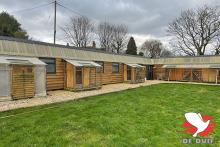 Breeding starts on the 5th of January with the first round from the breeders being floated under them. They are then split and repaired to be sitting for the first race of the season and widowed on return.
Breeding starts on the 5th of January with the first round from the breeders being floated under them. They are then split and repaired to be sitting for the first race of the season and widowed on return.
A team of 100 youngsters are bred for the race team and housed in 2 sections where they are raced on the sliding door for the early part of the young bird season and then paired and raced to the nest for the National races. 30 Youngsters are bred annually from the main couples and offered for sale after the season to pay for the costs of racing for the following year.
The young bird team are raced every week in the Fed with certain ones selected for the National races from the Channel points (Guernsey & France), National racing with youngsters is different from Fed racing with losses from a good race from France at 25% and 50% from a bad race. However losses with Old Birds are much lower than when the youngsters were only raced at Fed level. Youngsters who make a mistake early in their career and then return generally make into good racers when rested and then dropped back in competition.
Feed
Feed is a combination of Beyers Galaxy Sport Light, Vanrobaeys 35 and Gino Clique mixtures. Protein on return and carbohydrates mid week with fats introduced later in the week for the longer races. Plenty of light feed is better than small feed of high protein mixtures.
Less and less medication is used, Combi- Mix and Broncho Sprint from Schroeder Tollisan are used preseason and the mandatory PMV injection. Treatment is used in season when condition dips.
Pigeon Vitality natural supplements are used and mainly given over the feed, these are rated very highly by Ben but success is achieved with good pigeons, simple management and an eye to detail.
Auteur:

